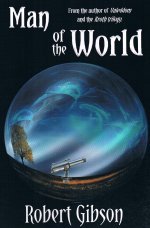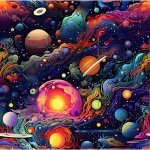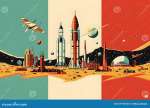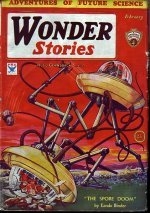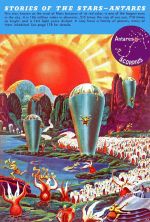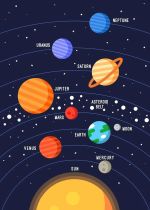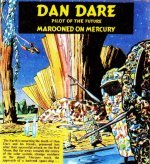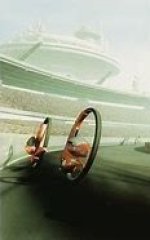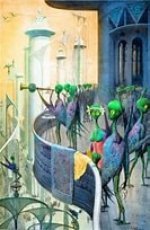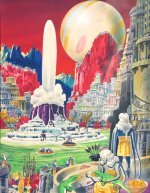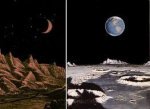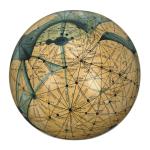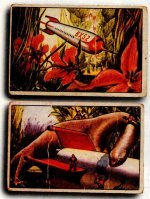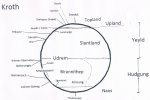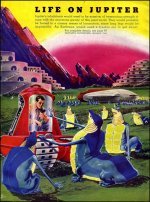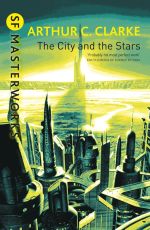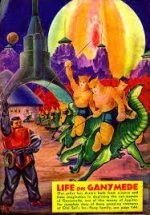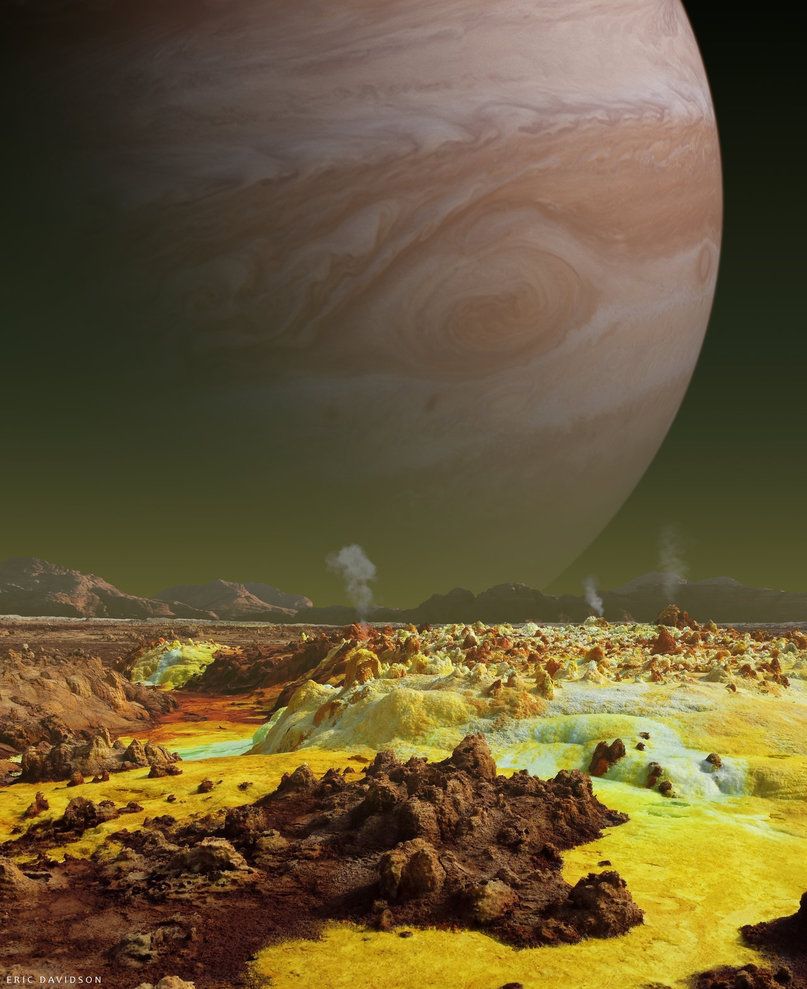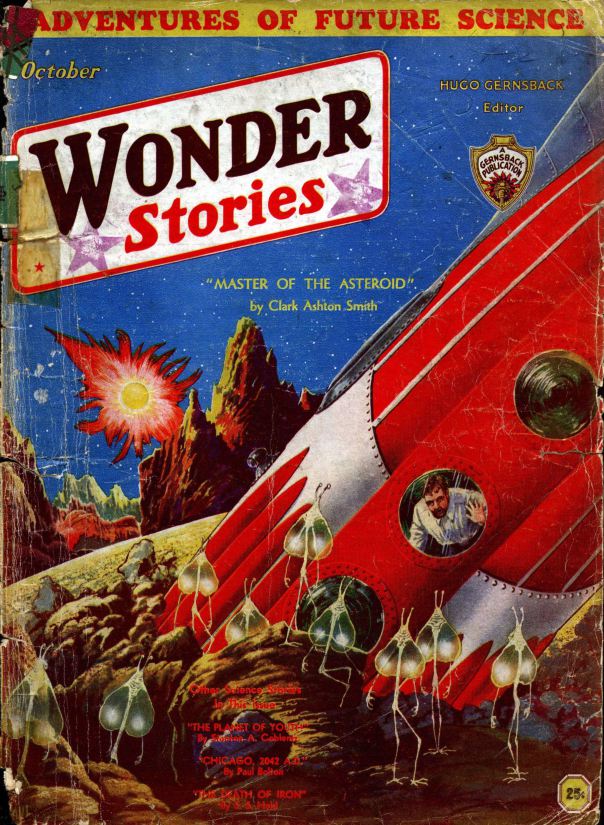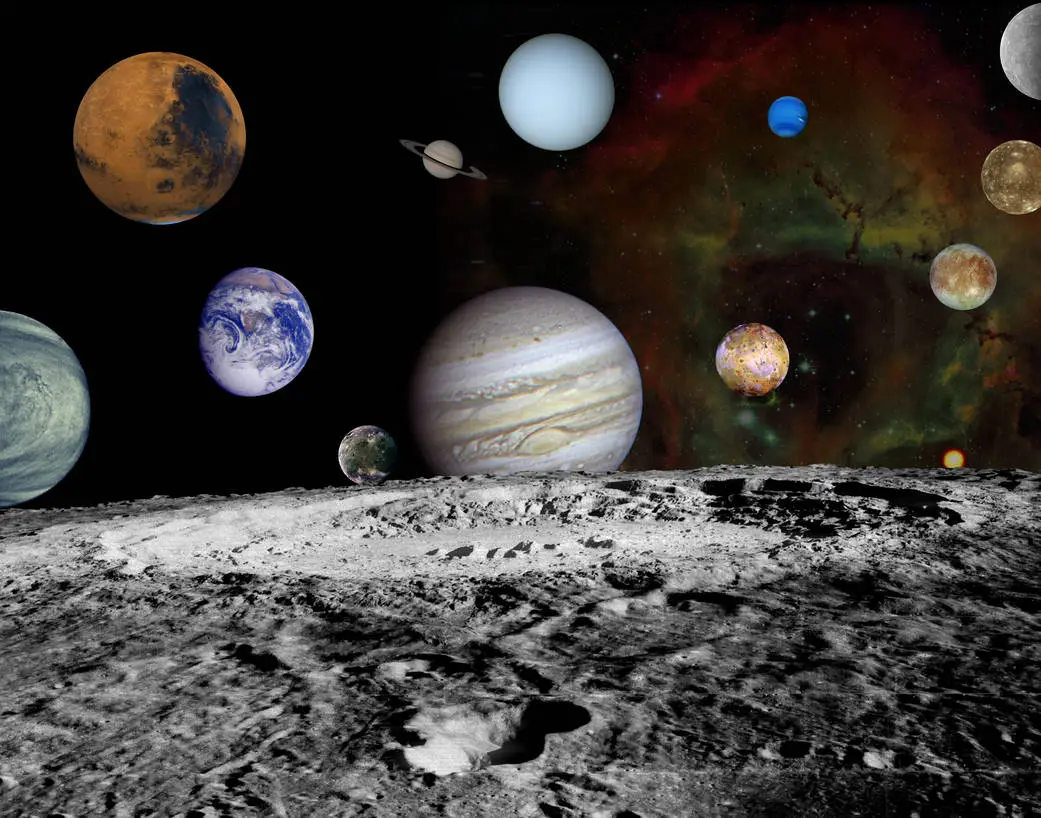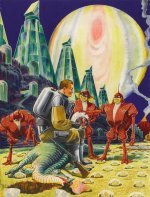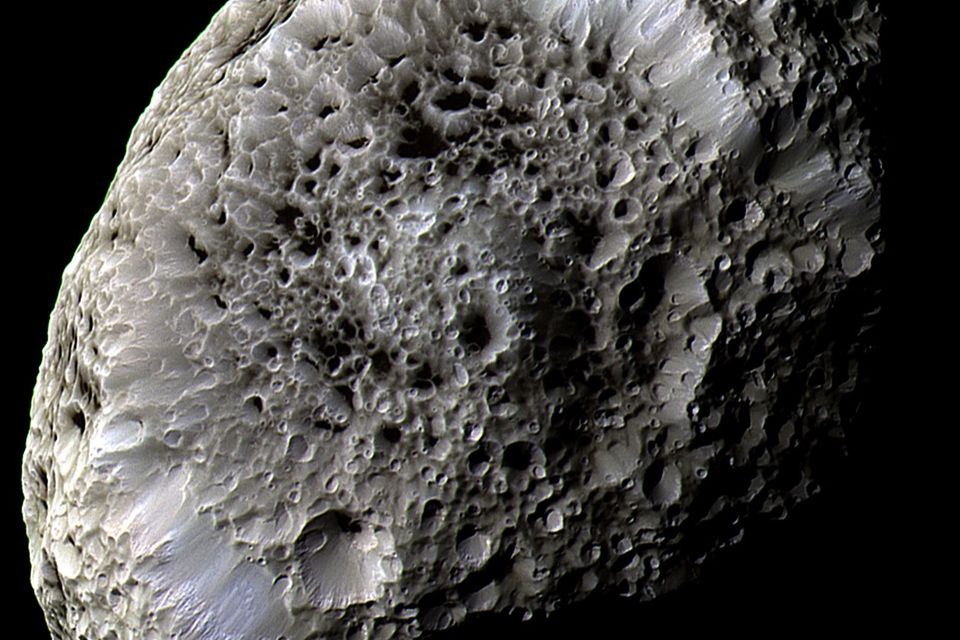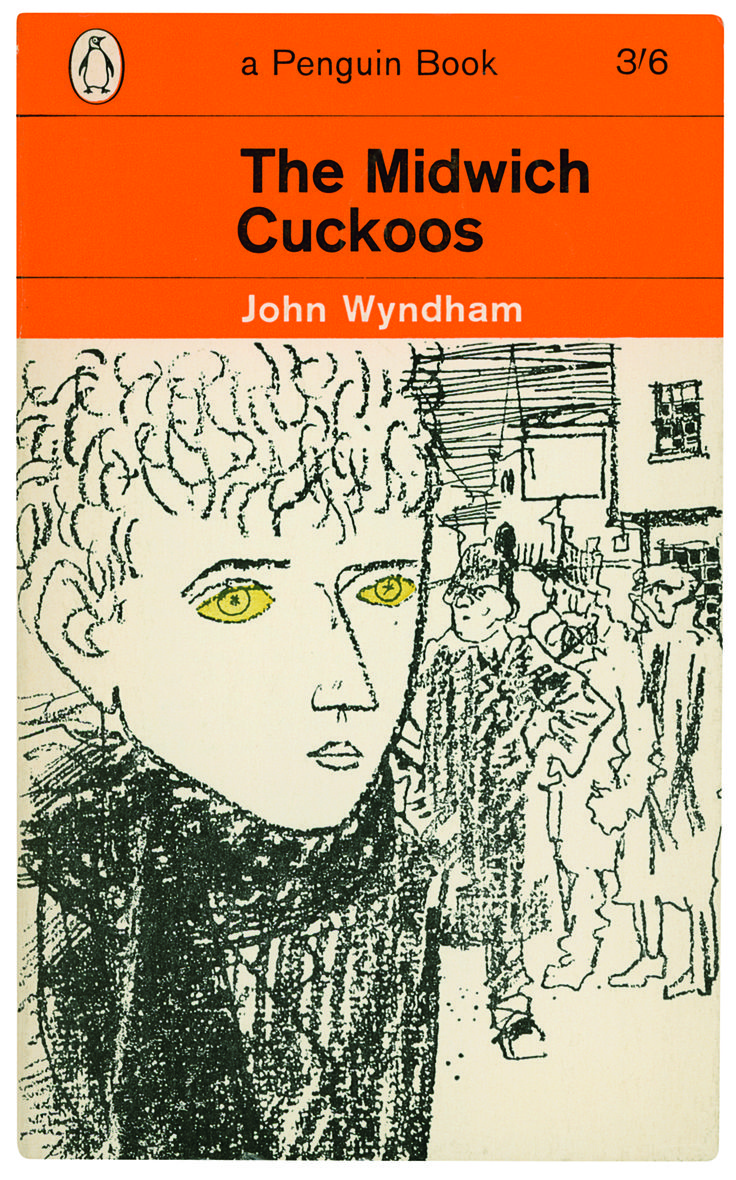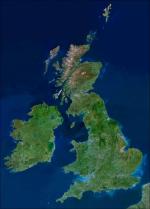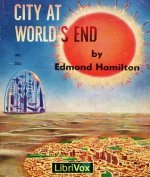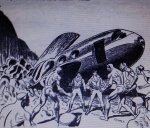the sunport vista:
zendexor's
oss
diary
march 2017
Thought for the day...
2017 March 31st:
INTERMISSION
No great diary efforts today, as I have spent some hours on doing a page at long last for H G Wells' The First Men in the Moon. Long overdue! Unfair, the way sometimes the greatest books get left behind in the race to get pages done; that's because a classic is an extra challenge - it's so hard to do it justice.
I doubt whether I shall ever do a page as such for The War of the Worlds, but that doesn't prick my conscience so hard, as the book has had quite extensive coverage on the site, scattered throughout various discussion pages.
The diary may have to take a back seat tomorrow as well, since I'll be so busy with the end-of-month stats...
2017 March 30th:
LONG LIVE TELEMORPHS
In my dogged campaign against COMOLD in the worlds of the OSS, I cheer up whenever I am able to seize upon evidence of convergent evolution.
Czuv the Callistan, on pp.129-130 of Doc Smith's Spacehounds of IPC, gives the following invaluable testimony:
"...In the evolution of the various forms of life upon Callisto, two genera developed intelligence far ahead of all the others. One genus was the human, as you or I; the other the hexan. This creature, happily unknown to you of the planets nearer our common sun, is the product of an entirely different evolution...
"Ages ago, then, the human and the hexan developed upon all four of the major satellites of the Great Planet, which you know as Jupiter, and upon the north polar region of Jupiter itself. By what means the two races came into being upon worlds so widely separated in space we know not - we only know it to be a fact..."
Now, if there'd been any standard COMOLD-style explanation involving ancient colonization to explain the distribution of humans and hexans, surely Czuv would have mentioned it. The fact that he does not even hint at anything of the kind, invites us readers to think up something much more interesting. Something which might allow the Callistans, Jovians, etc, to have real native identities.
It's time we had a word for what's wanted here.
I propose the phrase teleological morphogenetics, or teleomorphics for short, to describe a process of convergent evolution that gives more than mere "eye of an octopus" functional similarity - rather, it gives results like Burroughs' genetically unrelated yet sexually compatible Barsoomians and Jasoomians. John Carter of Earth and Dejah Thoris of Mars can produce offspring because they are telemorphs. In Perelandra, Ransom shares a common humanity with Tor and Tinidril without any common descent - they are telemorphs.
There's nothing like a handy word, to make an idea respectable.
2017 March 29th:
ASSESSING VAN VOGT AS A WRITER
In yesterday's Diary I was discussing two writers whom I (and doubtless most critics) regard as stylists. Clark Ashton Smith and Arthur C Clarke are surely writers whose power partly depends on their mastery of English. Other examples are Clifford Simak and Eric Frank Russell, who likewise put their own individual stamp on their use of the language. I would also class Edgar Rice Burroughs as an excellent stylist on his good days, though I dare say most critics would disagree.
Then there are "bad" writers, "bad" in the sense that they use language clumsily or without any sense of euphony. I would put Jack Williamson in this category. He wrote some great stories, but they're great despite his deficiencies as a writer. In sf, perhaps more than in other genres, you can make up in a blaze of imaginative power what you lack in literary skill. You can, in other words, write in the grip of an inspiration that wins over your readers, so that they hardly notice the clunk clunk of your prose.
And then we have A E van Vogt.
At his best he certainly counts as an inspired - madly inspired - story-teller. In his golden period his visions were unexcelled. Unfortunately for our sub-genre, not many of his tales were set in the Old Solar System, but out of those that were, you can't beat Repetition and Vault of the Beast.
He's great. But - stylistically - is he good?
I find this an extraordinarily difficult question to answer.
He is a master of the potent surprise, the slash of colour across one's attention, the sudden dose of sinister dramatic irony. Vault of the Beast is the quintessential example. I don't want to give extracts out of context, but here's one anyway. The man called Hughes is speaking to what he thinks is a human being.
Hughes interrupted: "Those are exactly the points which I am stressing. I knew you would see what I meant, Louis."
"Of course, I see," said the creature, smiling in grim amusement, for it was feeling very superior these days. "Your thoughts, your ideas, your code and your methods are stamped irrevocably on your brain and" - it added hastily - "you have never left me in doubt as to where you stand..."
In those few lines, in which we see the alien impostor slipping up - revealing its true nature by its inappropriate phrasing - we have some typical van Vogt. It seems like very good writing to me. All right, it may only be so because of the opportunities afforded by the genre. If so, let's give thanks for the genre.
2017 March 28th:
TECHNOLOGY AND THE COLOURFUL: CAS AND ACC
From somewhere or other I have gleaned the impression that Clark Ashton Smith had a stated aversion to machines, at least to some extent - and indeed much of his work is set in decidedly un-mechanised societies. You only have to think of Zothique, Hyperborea, Averoigne, etc, to get the point. Technology in the sense of craftsmanship there is aplenty, but not much in the way of boring mass-produced metal stuff.
That would suggest that his scenarios are limited to the pre-industrial - and yet he has written some superb Old Solar System space-age tales. The Martian culture depicted in Vulthoom is obviously far advanced. The Oumnis in The Immortals of Mercury, likewise. The Terran explorers in The Immeasurable Horror take sophisticated equipment to Venus (not that it enables them to depart unscathed). In these stories, the technology is present and powerful yet happily does not "grey" the plots.
Examples of this type of CAS story are few, precious, and significant. They demonstrate a "third way", beyond the either-or duality of "tech or no". They are neither primitive sword-and-planet stuff, nor whizz-bang "super-science". They allow technological themes to curl (metaphorically speaking) into gold-leafed ornaments of colourful splendour.
There is perhaps a whiff of this in Arthur C Clarke's far-future novel, The City and The Stars. Indeed, one would hope that the eventual fate of technology is, precisely, to "curl back" towards craftsmanship, eventually going beyond the stage of mass-production to return, ultimately, to more bespoke creations - aided perhaps by artificial intelligence. On the other hand his Solar System near-future adventures, Earthlight, The Sands of Mars and A Fall of Moondust, take another route. They do have the "grey" of technology. Nevertheless, such is Clarke's genius for suffusing scientific and technological matters in poetic imagery, that he can charm the reader into regarding the technical stuff as somehow humanized.
I suspect that the nuances which I have credited to CAS and ACC require a high degree of literary skill. Mere imagination, in such cases, isn't enough - in order to pull off the trick they have to weave an incantatory web of expertly crafted language.
2017 March 27th:
THE BIG HITTERS
We've now had seven of the monthly competitions in the Interplanetary Knock-Out series. Enough, maybe, to take stock and see if anything serious can be learned from all this sheer fun.
First, the champions (number of trophies in square brackets):
Mercury [1], Venus [2], Mars [1], Jupiter [1] and Saturn [2].
A good distribution across the System. In chronological order the victories line up as follows:
Jupiter, Saturn, Mercury, Venus, Venus, Mars, Saturn.
Too soon to tell for sure, but we might conjecture that the four-month "Inner System Reign" is likely to endure as a memorable feature of the competition's history.
Tides of public interest ebb and flow; thus one zone after another dominates, as we the readers reap the advantage of the variety of OSS scenes - the characters of worlds complementing each other with their amazing richness and uniqueness.
Because it's a five-round competition, the champions are those "teams" (pages) who managed to "win five matches" (get more hits than another page five times) in a row. But now let's see what the picture looks like when we broaden the investigation.
Let's consider all the finalists - those who won four-or-more matches in a row.
Mercury [4], Venus [3], Pellucidar [1], Mars [1], The Asteroids [2], Jupiter [1], Saturn [2].
Teams that aren't major planets now appear on the list. Interestingly, the Asteroids and Saturn both reached two finals (the difference being, the Asteroids lost both and Saturn won both).
Now let's go one level lower and consider all the semi-finalists - those who won three-or-more matches in a row.
Mercury [6], Venus [4], Pellucidar [2], Mars [2], Asteroids [2], Pallas [1], Jupiter [6], Saturn [5].
From this semi-final perspective it seems the two strongest teams are Mercury and Jupiter; whereas from the finals-perspective the two strongest are Mercury and Venus; and from the champion-perspective, Venus and Saturn.
Knock-outs are a chancy business, but they do have the capacity to highlight sudden surges, and this "surge" phenomenon is one I've notices on the site's statistics quite a few times. Two notable examples in the past year - though they didn't chance to affect the competition results - have been a Pluto surge and a Triton surge, both dramatic and temporary.
2017 March 26th:
AN ALTERNATIVE TO THE PROGENITOR PLANET
It's a romantic idea - and classic OSS trope - that there was an asteroid progenitor planet, the destruction of which produced the belt of minor planets between Mars and Jupiter.
Isaac Asimov, however, wasn't one for backing tradition over up-to-date science, and in Lucky Starr and the Pirates of the Asteroids (1953) he plumps for the truth:
...Once it had been thought that there had been a planet between Mars and Jupiter and that geologic ages earlier it had exploded into fragments, but that wasn't so. It was Jupiter that was the villain. Its giant gravitational influence had disrupted space for hundreds of millions of miles about it in the eons when the Solar System was being formed. The cosmic gravel between itself and Mars could never coalesce into a single planet with Jupiter pulling and pulling. Instead it coalesced into myriads of little worlds...
Now although the Progenitor Planet is safely lodged within the bounds of legend, and thus needs no justification for its inclusion in stories, Asimov's words do remind me that there is something, equally story-friendly, to be said in favour of the "coalesced cosmic gravel" idea.
Playing identity-politics, as I so often do, I can see that the characters of the mini-worlds could be regarded as more individualistically their own, if they were never part of a large planet. It's like the way I prefer the Moon to have been formed on its own or by shared material from a collision between Earth and another body, rather than simply having split off the Earth.
Moreover, there is another idea I can glean from Asimov's paragraph. An idea he would never have meant to give me - it would be far too mystical for him. Here goes:
It was triggered by his sentence "It was Jupiter that was the villain."
He meant it figuratively, of course. He was just using colourful language to convey the idea that Jupiter was the cause. Nothing really villainous about it.
But we can take it further. We can imagine some ancient drama in which gravitational disruption is used deliberately, perhaps by a race of advanced Jovians, to prevent the accretion of a possible rival planet...
Whoever writes such a story would face the sizeable challenge of having to think up a reason why these processes were not merely automatic. What scope could there be for deliberate manipulation?
I leave it to you, folks - if any of you are looking for a YOSS (Young Old Solar System) plot...
2017 March 25th:
THERE'S TIME FOR EVERYTHING
Here's a riddle for you: what connects this wonderful 1934 map of Mercury by Antoniadi with the mind-stretching book The Five Ages of the Universe (1999), by Fred Adams and Greg Laughlin?
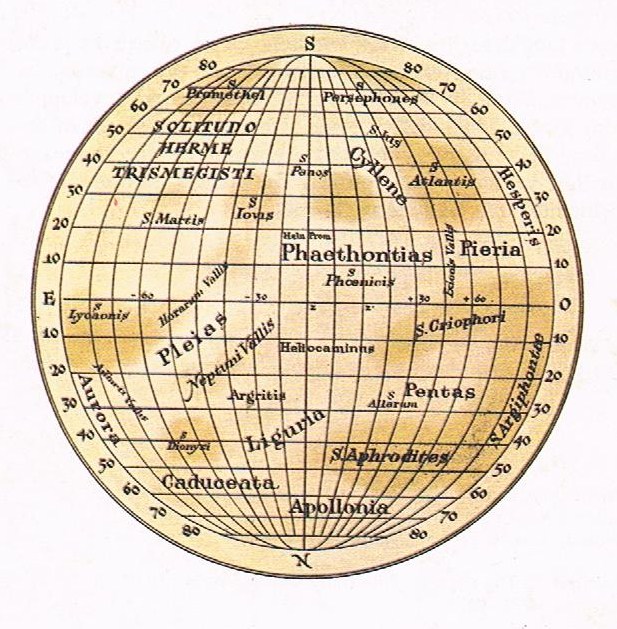
Before answering the riddle let me say a few words about each item.
Eugène (I give the familiar French version of his name) Antoniadi was a Greek astronomer invited to France by none other than Camille Flammarion. He worked at Meudon Observatory. His book on, and map of, Mercury constitute a sort of classic summing-up of the old belief that the planet had synchronous rotation. It was strictly scientific, for the time, but turned out to be all wrong (alas).
The 1999 book by Adams and Laughlin is likewise non-fiction. It is an epic summary of speculations about the history of our universe from its far past to its much further future. The "five ages" it describes are:
1. The Primordial Era. 2. The Stelliferous Era. (That's the one we're living in now.) 3. The Degenerate Era. (That will be dominated by the "degenerate matter" now to be found only in white dwarf stars.) 4. The Black Hole Era. 5. The Dark Era.
The eras are dated in "cosmological decades", which are on a logarithmic scale, increasing in length by orders of magnitude. So for example our Stelliferous Era lasts from "decade" 6 to 14, i.e. from the time when the universe is about 1,000,000 years old to when it is about 100,000,000,000,000 years old. And the Degenerate Era will take us forward to decade 39, which is therefore a number of years with 39 zeroes following the 1.
For planetary life I don't think we need worry about the Black Hole Era (to decade 100) and still less the Dark Era which is to follow. The book out-Lovecrafts Lovecraft in its ultimate cosmic gloom - but I love it. After all, we can hope that new universes will bud themselves into existence by quantum fluctuation at any time... meanwhile let's focus on the first 30 or so "decades" of our universe; that is, the time that's left to us before proton decay sets in - about a million million million million million (ten-to-the-thirty) years, give or take a few zeroes.
(Let's also assume that the scenario which the authors describe is not substantially altered by the discovery of "dark energy", which is not mentioned at all in their book, and which occurred at about the time of its publication. I'm just cutting down on the complications.)
So we have all this time in front of us. What will happen?
Just about anything, I'd say.
Including Reality Options. Dream Holidays. Visits to...
Antoniadi's Mercury - among other versions.
Mind you, it's only rock - but those wonderful names beguile me. Solitudo Criophori...
2017 March 24th:
COMBAT IN THE ARENA
Gladiatorial combat is such a cultural feature of life on Barsoom, that I am neither surprised nor disappointed to find the theme duplicated on Lin Carter's Thanator. At first glance, the theme of lethal arena-games seems to have inserted itself thoroughly into the very idea of a sword-and-planet series. It has become part of what one can take for granted.
On the other hand, a few interesting and slightly surprising points have just occurred to me.
First, on Barsoom itself, I don't recall the arena-theme occurring at all within the precincts of the planet's top centre of civilization, the Twin Cities of Helium. It's as though Burroughs wants to leave the option open, that without making a fuss about it he wants to enable us to believe that the Heliumites are rather a cut above that sort of thing.
Most likely, I reckon, he did not work it out, but we - in making such observations - can (as it were) map his psyche on the issue; we can guess he didn't want the image "Helium" combined with the image "gladiatorial combat".
Thus we can draw one more little pencil mark on our increasingly detailed map of the moral contours of Barsoom.
It's a subtle map. The Barsoom tales depend upon a kind of moral live-and-let-live, within certain limits. We can explore those limits by studying the themes of slavery, war and violence, and how the moral questions they raise are all subordinated to the requirements of story.
For instance, regarding assassination, we can cite the attitude of John Carter, the Earthman, towards assassination, a theme well set out in the first chapter of Swords of Mars. He deplores the practice, but does not look down his nose at his Martian friends who accept it. The topic of assassination and its place in Barsoomian ethics is also brought out in the ambiguous character of Gor Hajus in The Master Mind of Mars. The short-range simplicities of ERB's scenes are paralleled by a long-range subtlety in the ways they fit together. But again, I guess he did it by instinct, not by working it out consciously. Assassination and the arena-theme, therefore, in their variations of application or non-application, are examples of how the various aspects of Barsoom fit together loosely, like the loose molecular bonds of water, causing a liquidity of freedom in the series as a whole.
This brings me finally to another observation about the variety amongst ERB's tales - namely, between one world-series and another. For my second main point is that the arena-theme does not, so far as I can recall, occur at all on his other main world-series, Amtor.
Why this difference hadn't struck me before, I don't know. But it seems to be a fact - ERB's Venusians, though quite used to fighting with swords, haven't opted to do so for the amusement of crowds, Roman-style.
If he had had similar instances of The Games on both planets, it would have detracted from each. Fortunately, he wrote by instinct, and his instinct played true. His Mars and his Venus aren't cut from the same cloth.
2017 March 23rd:
PERHAPS NO LOSS
Many readers must have asked themselves the question, "What on Earth happened to H G Wells, after he finished The First Men in the Moon?" That masterpiece, that culmination of his art, came out in 1901, the year he turned 35. After that, what? Enjoyable mainstream novels, yes, such as The History of Mr Polly and Tono-Bungay. Interesting speculations in The Shape of Things to Come. Loads of rather dated political novels and tracts which one can doubtless mine for nuggets of wisdom. But the freshness and verve of his science-fictional story-telling genius seems to have deserted him. Compare the unputdownable First Men in the Moon with The Food of the Gods which came out just three years later. I find the latter virtually unreadable.
Now, the usual way to consider this is negatively, for example "What a shame; if only he had stuck to his brilliant vein of sf, what wonderful books we might have had from him in the following four-and-a-half decades of his life".
However, I've just thought of another way of considering the phenomenon of Wellsian decline.
Put it this way. Let's say Wells the sf writer might as well have died after 1901 - in a way, did die. What could this tell us about other authors who really, literally, did die young?
Stanley Weinbaum, for instance. Here we have an obvious example of a tragic loss - an innovative genius who succumbed to cancer in his early 30s, after producing wonderful stories for just a couple of years.
Also consider, in the related genres of fantasy and historical fiction, the case of Robert E Howard. He killed himself aged 30, a fact which must break the hearts of legions of fans of his Conan stories.
Sad losses - but is it not possible that the losses, while personal tragedies, were not actual losses to the particular genres which mourn them? Supposing, if they had lived, they had "done a Wells"? For it's possible they might have done - might, that's to say, have backslid from the type of writing for which they are now remembered, and switched to other genres. Weinbaum might well have gone mainstream; he was, I believe, planning a mainstream novel. Howard - so I gather from browsing in a biography of the man - was perhaps at the end of his inventiveness as regards the Conan stories.
It's worth remembering that Clark Ashton Smith (1893-1961) produced most of his tales in the relatively short period 1928-36, when he needed to sell stories to support his parents. He did write some good stuff later on - for example The Metamorphosis of Earth (1951) - but substantially his fame depends on what he had already achieved a quarter century before his death.
Most writers change, and it is not safe to assume that if they had been granted some extra decades they'd have given us more of what we want from them. A writer as evenly consistent over several decades as was Edgar Rice Burroughs is, perhaps, a rarity. So if we were to visit an alternate time-track in which H G Wells was run over by a bus in 1902, we could tell his grieving fans, yes, it's sad, but don't bother regretting all the further sf masterpieces which he would have written - because, actually, he wouldn't.
2017 March 22nd:
PLANET D'ARTAGNAN
One things leads to another, and as I've been reflecting upon French history (see yesterday's Diary) I got to pondering the special aura of Dumas' novels set in the 17th century. I haven't read them all, but I have avidly read The Three Musqueteers, Twenty Years After, The Man in the Iron Mask and The Black Tulip. And I can see some parallelism between their milieu and that of Barsoom. I'm not just making an obvious point about the swashbuckling and the swordplay.
It's more a case of investigating the psychology of the reader - in this case, the one I know about, namely myself, and presumably, by extension, others too.
Burroughs and Dumas didn't just master a milieu (in Burroughs' case, a wholly imaginary one). They also achieved a high degree of what I might call moral creativity. I mean to say, here am I, a democratically inclined Christian who's supposed to believe in humility and chastity, and yet I lap up the doings of D'Artagnan with his pursuit of Mme. Bonancieux and his readiness to slay on a point of honour, and John Carter with his acceptance of Martian slavery (not surprising in an ex-Confederate soldier) as well as his bloodthirstiness which excelled that of the Frenchman at times.
In both Dumas-land and Barsoom, we are treated to a special kind of splendour which dazzles by its sheer force of character. The power of great literature can thus create a kind of bubble of acceptance and belief, which lasts as long as we hold the book in our hand. It's more than a case of "making allowances". I actually don't want D'Artagnan or Carter to "reform"; I want them just as they are. Can anyone work that out? I can't - it's just how it is.
I would add, though, that there are other voices in Dumas, apart from that of D'Artagnan (who, by the way, was a real historical person). There is the more philosophical Athos, whose reflections upon history in The Man in the Iron Mask I found most memorable. And there is the more politically "activist" Aramis - a rather mysterious character.
For me, the Dumas novels aren't "standalone" books - I would not have enjoyed them nearly so much if I had not already known something about seventeenth-century France and been interested in that place and period. However, that's not at all a criticism of the books. You might call them sequels to reality. That's fair enough.
And be it noted that for some of the characters in Heinlein's Universe, The Three Musqueteers was a standalone book. Here we have people, mutants, on a generation-starship gone wrong, who have forgotten it is a ship and think it is the world. They have no chance at all of understanding what Earth was, or what any real planet is like. But they have books on board, and they read them as well as they can. The tales mean something - goodness only knows what - to these lost space-farers. I find that moving, and especially their quotation in extremity of the phrase, "All for one and one for all".
2017 March 21st:
ANOTHER MYSTERIOUS ANCIENT TERRAN REALM
It's occurred to me since writing yesterday's Diary that I might be accused of undue nationalist bias, even of harbouring the ridiculous belief that Brits are better than other people. Actually, it's just that I know more about my own country than about others - naturally enough.
However, let me now write about another country. I am inspired by Clark Ashton Smith's wonderful Averoigne tales to display some French millennial date-resonances in the same format as those I showed yesterday for Britain. They're harder to find, as my knowledge is more patchy, but here goes:
629, "le bon roi Dagobert" (see the song) becomes the last powerful Merovingian King of the Franks; 1629, the rebellion of the Huguenots is brought to an end by Louis XIII's government (this is an important date, when the Huguenots lost their state-within-a-state but for the time being retained their religious freedom).
778, a part of Charlemagne's army is ambushed in Roncevaux Pass by the Basques (greatly distorted legends of this incident eventually inspire the Chanson de Roland). 1778, death of the renowned philosophe Jean-Jacques Rousseau.
814, death of Charlemagne; 1814, abdication of Napoleon. (Amazing imperial resonance there!)
Sorry, can't think of any more. It would be good for such millennial date-rhyming if I could find some notable French events of AD 1511 (to match the accession of Clovis in 511) or 1987 (to match the accession of Hugh Capet in 987) - or conversely of AD 870, 914, 940, 962, 968, 970... to match those of 1870, etc, etc.
Anyhow, maybe my French readers (who've been silent so far) can chip in here.
No doubt about it, Earth is quite a planet.
2017 March 20th:
WHIMSIES OF TERRAN HISTORY - A MYSTERIOUS ISLAND
In the page on Star's Reach, I have discussed the theme of Earth's graduation to the rank of hauntingly ancient and mysterious planet. It's an added interest that the book is set in America, thus showing the "New World" becoming old - a fascinating process we can slowly witness occurring in real life, as America acquires more layers of tradition and history over time.
Meanwhile, what of the ancient island on which I live? Whimsy makes me suggest that Britain may become to America what Sotar was to Zothique...
Not looking ahead quite so far, I want to share some cute 1,000-year resonances with my readers. For the history of Britain is long enough for many date-pairings a millennium apart.
Examples:
642: death of the great St Oswald, King of Northumbria, in battle against the pagan Penda of Mercia; 1642, beginning of the English Civil War.
685, the defeat of the Northumbrians by the Picts; 1685, the defeat of Monmouth's rebellion by the forces loyal to James II.
In 878 King Alfred was hiding in the Somerset marshes, preparing his counter-stroke against the Danes; in 1878 Prime Minister Disraeli was enjoying his triumph at the Congress of Berlin, winning praise from Bismarck.
939, death of Athelstan, King of the English; 1939, Britain enters the Second World War.
954, the absorption of Viking York into the Kingdom of England; 1954, end of rationing, and Bannister runs the four-minute mile.
I could go on... Most of these resonances are bound to be like the assonances in poetical rhyme - devoid of strict logical connection, and memorable merely because of some trans-logical "music". But one at least of them provides a contrast which is thematically apt:
1016 - England succumbs to foreign domination under Cnut.
2016 - the vote for BREXIT...
I wonder what we'll do in 3016?
2017 March 19th:
THE NEEDLE SWINGS ON SASSOOM
I've never gone treasure-hunting; never used a metal-detector. I have no idea what the indicators on such a gadget look like, and I would not be surprised if, in this digital age, things like dials with swinging needles are passé. Never mind - I feel a metaphor coming on and am determined to employ the sudden dramatic veer of a detector needle in my figure of speech.
The "treasure" we're looking for here is - as always - an understanding of the X factor in our sub-genre of literature. What makes it tick? There isn't just one answer. There are various lodes... veins of ore... mascons of truth.
One of these, which gets the needle on my detector swinging, and which is just asking to be dug up and investigated, belongs to that class of lodes which emit gawions proclaiming: "Here I am, a contradiction that works! Something strange and powerful is going on here!"
The contradiction in this particular Lode is as follows:
"Look at the let-down you experience when you come across Astor's mention of pine-trees on Jupiter" (see yesterday's Diary). "Imagine what a let-down it would have been, if Burroughs had had any items of Earth flora or fauna on his Jupiter. Immediately it would have spoiled the literary magic. Yet this same literary magic was not spoiled by the presence of the human Savators on that same ERBian Jupiter. That world - Sassoom - embodies the same contradiction as Barsoom and Amtor: namely, an alien world with alien flora and fauna, yet also with humans, who are genetically unrelated to us yet capable of interbreeding with us. A massive contradiction which somehow, in story terms, works."
Stid: You may say it works, Zendexor, but a lot of more discriminating intellects would say it doesn't; they'd say that, far from "working", the contradiction you mention makes it impossible to take these tales seriously.
Zendexor: You're entirely missing the point, Stid. You're actually underestimating the contradiction. Nobody expects science-fantasy to possess scientific accuracy, but like all forms of literature it depends upon a certain imaginative and emotional coherence. The mystery here is how such coherence can allow the same reader to feel (a) let-down by natively evolved Jovian pines and (b) not let-down by natively evolved Jovian humans.
Harlei: Look, Zendexor! Your detector needle is swinging madly!
Zendexor: Yes, because we're now standing directly on the patch where the treasure is hid. This, therefore, is where we need to dig. Dig deep and uncover the principle which is allowing humanity to be an exception as far as peopling alien worlds is concerned. For in our analysis of our own emotions - which is the way we progress in this empirical science of OSS criticism - we have found that the Burroughs formula works, but we don't know exactly how. The answer lies somewhere here, in this particular area of our minds... so here goes: out with your spades, folks.
2017 March 18th:
JOVIAN FLORA: SINGING PLANTS YES, PINE TREES NO
I'm currently ploughing through one of the worst-written books in history, John Jacob Astor's A Journey in Other Worlds (1894). I find it's worth the effort, because its ideas, and its place in the historical stream of sf literature, cannot fail to be interesting. Here after all is a work published just before the proper dawn of our genre; it is therefore in some respects a crepuscular or penumbral entity straddling the pastward borderline of OSS tradition. One doesn't read such a book for normal reasons of entertainment but rather for curiosity's sake. In my case, I wanted above all to know how the planets were portrayed in fiction in the year 1894.
Well, it's been worth it, to learn so much about the Jupiter of that year.
It's a bit like the Mars of Gustave Le Rouge's duology of 1908-9, insofar as the supposedly alien planet has some animal and plant life-forms which seem more or less identical with those of Earth - a big disappointment for the reader - while it also contains some genuinely alien forms.
In Astor's Jupiter we have, on the credit side, the singing plants, whereas on the debit side we have copycat dinosaurs like those in Earth's past, and (this is a real let-down) pine trees.
One point in Astor's favour: though the climate and atmosphere of his Jupiter are Earth-like, he nevertheless takes the gravitational difference seriously. He seems interested in the geophysical implications of a high-gravity world.
...the vapoury curtain was drawn aside, revealing a waterfall of such vast proportions as to dwarf completely anything they had ever seen or even imagined... Two things especially struck the observers: the water made but little curve or sweep in passing over the edge, and then rushed down to the abyss at almost lightning speed, shivering itself to infinitesimal particles on striking any rock or projection at the side. Its behaviour was, of course, due to its weight, and to the fact that on Jupiter bodies fall 40.98 feet the first second, instead of sixteen feet, as on earth, and at correspondingly increasing speed...
You may wonder why I had such harsh words to say about the way this book is written. After all, the above passage is not at all bad. Well, let me tell you, it's the dialogue that drags it down. If you can call it dialogue... every time one of the the characters opens his mouth, he speaks as though delivering a lecture, and a dry lecture at that. If you were the first ever traveller through the asteroid belt, and beheld the awesome sight of Pallas zoom past the window, showing mountains fifteen miles high, I doubt if you would comment to your companions in this style:
..."There being no air," said Cortlandt, "it is safe to assume there is no water, which helps to account for the great inequalities on the body's surface, since the mountains will seem higher when surrounded by dry ocean-bottom than they would if water came halfway up their sides. Undoubtedly, however, the main cause of their height is the slight effect of gravitation on an asteroid, and the fact that the shrinking of the interior, and consequent folding of the crust in ridges, may have continued for a time after there was no longer water on the surface to cut them down..."
And it's not just Cortlandt. They all talk like that - replying to one lecture with another, in exactly the same tone.
Nevertheless, it's an interesting book. I have got into the habit of reading a page or two, last thing before I turn the light out.
2017 March 17th:
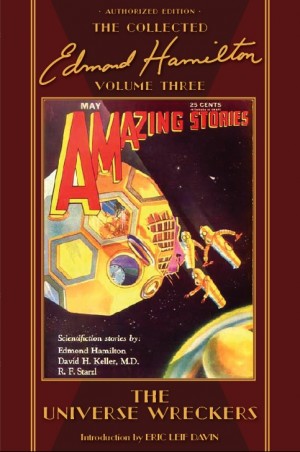
THE IDEAL GIFT FOR AN OSS FAN
I have mentioned before, how superb is the ongoing series of volumes published by Haffner Press, The Collected Edmond Hamilton. But there is an aspect of these books which perhaps I have not yet stressed enough.
It's not just the stories - it's the contemporary artwork, feedback and chit-chat!
At the end of each volume the reader finds, to his or her delight, a section lavishly endowed with illustrations from the sf pulps, plus extracts from the letters pages of Amazing Stories, Astounding Stories, Weird Tales and Air Wonder Stories.
For example, let's look at the last 100 or so pages of the 700-page Volume Three: The Universe Wreckers.
Just browsing in the October 1930 Amazing Stories letters column I find:
[From Harold Jones, Des Moines, Iowa:] Now, I want to ask a question. If a space ship was flying to Jupiter, couldn't it avoid the asteroid belt by going over or under it?... See you on the moon in 1960.
[Editor's reply:] It is interesting to get a letter from an editor of a science class paper in a high school... The asteroid belt could be avoided as you suggest, but our writers on interplanetary travel seem to like it.
[From Edward I Huscher, Panama Canal Zone:] ...Saturn appeared to be a yellow glowing disk when they were approaching at five million miles per minute. When going away from the planet at the same speed, she still appeared yellow. I would think that a difference of ten million miles per minute would make some difference in the apparent color...
[Editor's reply:] ...If our readers want interplanetary stories, as they certainly do, we must allow a good deal of latitude, such as Mr Hamilton, who is greatly admired by our readers, employs...
And so on and so on, page after page, as interesting as the tales themselves (if not more so... as Hamilton was still getting into his stride at this time; I have argued elsewhere that 1932 was his breakthrough year - for which see Volume Four: The Reign of the Robots).
No doubt about it, these books are redolent of the good old days.
2017 March 16th:
THE VODARO ALLOTMENT
No, that isn't the title of a Robert Ludlum thriller.
I'm just continuing yesterday's somewhat fevered speculations...
Up till now I have been thinking of reality-engineering as a finished act, with regard to its consequences rather than to its initial implementation.
But the decision-making that goes into could, in itself, furnish the plot for an epic.
Imagine a far-future society in which men have acquired almost god-like powers, like the pocket-universe-creating Lords in Philip José Farmer's World of the Tiers series, or like the pseudo-Hindu pantheon in Roger Zelazny's Lord of Light. Only, the powers would be even greater than those shown by Farmer's and Zelazny's protagonists, in that they'd involve the retrospective grafting of a "new" past onto history, so that what they create has, "afterwards", always been. (New verb tenses needed here!)
Now, imagine the debates preceding this action. Imagine how policies might be thrashed out.
"We want a lush Venus." "Right - let's have the Sea of Morning Opals." "The deadly, beguiling plants found by Hotar and Evidon." "Some of the floating islands of Tor and Tinidril's realm." "Hang on - don't forget to fit in the giant trees of Vepaja."
Imagine the trade-offs, the wheeler-dealing amongst the reality engineers... There wouldn't be room for everything, but there'd be room for a lot. Cloudily mysterious Venus is more amenable to multifariousness than a transparent-aired world like Mars. Both planets are, of course, planets of mystery. But whereas Mars is more unifiable, because its vistas are clearer, Venus can be almost several worlds in one, as Carson Napier found in his wanderings. On Mars you do, of course, get lost cities and remote valleys harbouring unsuspected civilizations; Kamtol, Horz... But on Venus you can come across whole unknown continents.
As Carson says to himself, after inventing a story that he is from the continent of Vodaro:
...I remembered having seen a land mass called Vodaro on one of Danus' maps. It extended from the southern edge of the south temperate zone into the terra incognita of the antarctic. Danus said that little was known of it. I hoped that nothing was known of it. Nothing less than I knew of it could be known.
And indeed, in the four Amtor books, we get no information about the real Vodaro at all; whereas in the Barsoom series we end up with a fairly substantial survey from pole to pole of the Red Planet.
But when the far-future wheeling and dealing reality-engineers begin their bargaining, they may well seize upon the chance to overlap "Vodaro" with some other author's concept. It's a blank waiting to be filled...
2017 March 15th:
MAKING USE OF A USELESS PLANET
I think it was Larry Niven in A World Out of Time who makes one of his characters dismiss Venus exasperatedly as "that useless planet". And from a realistic point of view one can see his point. An almost Earth-sized world, but uninhabitable, with an atmospheric pressure of 90 bars, temperatures in the hundreds... All right, it just might be possible that there is microbial life floating in the upper atmosphere. But still - how much further can you get from the lush Venus of the Old Solar System?
And then I think also of the Outer Planets, the giant worlds on which we can never set foot... and that brings to mind the "reality engineering" which (in the future envisaged by Robert Gibson) will one day improve Uranus as Ooranye.
These thoughts lead me to reflect that if ever our species does advance to the fantastic level at which reality engineering - retrospective grafting of a better past - becomes possible, then, rather than the gas giants, it might be Venus where the process is tried. I am suggesting Venus might be the candidate world for the first attempt, because of its nearness and because, for all its faults, it is at least solid.
Of course these are scarcely believable ideas. But just supposing our species survives for many hundreds of thousands of years, and solves all its practical problems, yet still does not manage to achieve interstellar travel. In such a case, we would be strongly motivated to make the best of our Solar System. And rather than mere terraforming, "making the best" might by that time come to mean something more ambitious. Our remote successors might be more picky. They might want a greater variety than would ensue from the "terraforming" attitude. They might look back for more varied inspiration. Back, back through time... to the literature of the Old Solar System!
In which case, what we read, and write, might have its effect upon decision-making, and upon reality, in the far future.
For it might be a rule that "if you can think of it, it will one day happen..."
2017 March 14th:
DAFT-PLOT TOLERANCE
Yesterday I discussed the power some spinners of yarns have, of bamboozling us gravitationally.
Another sign of greatness - and another display of GAWI - is when an author gets us to enjoy a book with a ridiculous or incoherent plot.
Let me stress that I am not being ironical here. I really mean it when I say, that great writers can show their strength by their failures: provided that the failures in one area of their art are made good by successes in another.
And it sometimes happens that they achieve this compensation so effectively, that we even get to feel fond of the failure - as though it were the other side of the coin of success.
I'm thinking of Dreadful Sanctuary (1948) by Eric Frank Russell.
I've read and enjoyed this novel many times. It is fun - exuberant fun. But I have to shunt it into a sort of "parallel universe" in which plots don't have to make much sense.
The pivot of the story, though not one of the main characters, is a "mighty-domed old dodderer" named Horowitz, who establishes some kind of ascendancy over a set of people who call themselves the Norman Club, Norman being short for Normal-Men, sane men - who claim to be transplanted Martians.
I'll leave it at that. Believe me, once you've read the book (and, I trust, enjoyed its rollicking style and classic Russell humour), you'll be asking yourself questions like, how the heck did this Norman Club get started, what was the point of it all, et cetera.
The conspiracy is formidable, technologically as well as politically - they have a special weapon, a sort of coagulator that causes blood-clots, which is obviously the fruit of a unique line of research. But the more impressive the conspiracy, the harder it is to understand what really keeps it going. At least, I find it hard. But perhaps one of you can explain it to me.
These objections only occurred to me many years after first reading the book. At first I was captivated, bamboozled, infatuated by the tale's sheer vim and vigour. Also it's tempting to freeze-frame the action at those points where the likeable hero, John J Armstrong, a tough yet reflective character, is tempted to see truth behind the "Norman" assertion that Earthlings are nuts. I particularly like the scene in the cinema, where an advert for a new juke box gets the audience freaking out with "Runny Runbaken's Runnerbeans playing Skiddin' with My Shiver-Kid".
His eyes now accustomed to the half light, Armstrong looked sidewise, studied the faded blonde sitting next to him. Her jaws were working rhythmically, her eyes fastened to the screen with a sort of dull intensity, her left foot tapping in time...
Averting his gaze, he transferred it to the opposite side, found there a vapid youth, his mouth hanging open, his eyes bugging straight ahead, his well-padded shoulders twitching to the same crazy beat...
Nudging him with a heavy elbow, Armstrong snapped, "Poostermoolies!"
The vapid one gave a violent start, ceased his twitching, turned his popping optics to the other. "Eh?"
"Poostermoolies," growled Armstrong, standing up.
"Oh, sure!" The youth drew in his legs to let Armstrong pass. After the brawny figure had gone, the young returned his attention to the screen, his mouth hung open again, never a thought of what poostermoolies might mean entered his mind. As Armstrong had known, any word would have done to obtain the required reaction.
Armstrong went home. Something deep in his brain was curling and contorting like a mutilated snake...
Yeah, I know the feeling.
2017 March 13th:
SUSPENSION OF GRAVITATIONAL DISBELIEF
What links Burroughs' The Moon Men, Stanley Kubrick's 2001: A Space Odyssey and Brackett's The Lake of the Gone-Forever?
(Apart from the fact that they're all good.)
Burroughs has his Lunarians invade Earth with no apparent ill-effects from the six-fold increase in gravity.
Kubrick's film has outdoor scenes on the Moon in which men in spacesuits hop around with realistic slowness, but then has indoor scenes on the Moon in which people walk around in a fashion that looks quite normal for those under Earth gravity.
Brackett's tale is set on an asteroid, where the gravity must be minuscule, yet people's movements again seem Earth-normal.
In all of this, I'm not criticising, I'm admiring - in a state of wonderment, as to how our minds work to ignore the impossible in these particularly blatant cases.
For surely there is something fundamental about gravity. One would think that to get it so drastically wrong must wreck a story. And yet it doesn't. So - some greater power must be maintaining the imaginative credibility of the stories.
I think there must be a "fifth column" inside our brains which is determined to co-operate with the bamboozling power of a tale, provided the said tale is sufficiently well provided with other virtues.
This "fifth column" churns out subliminal excuses at so rapid a rate, that it would cost our conscious minds a great deal of effort to pin the process down. But let me try, for example in the case of The Lake of the Gone-Forever.
The excuses might work on these lines:
There could be different sorts of gravity. (Actually, this reminds me of some of the ideas in The Arc of Iapetus.) Little asteroids might have a gravity based on their peculiar cultural status - a kind of mind-over-matter thing, whereby small worlds have a localised pull, which does not affect the System as a whole in the way "normal" gravity would.
There, you see! I'm doing Leigh Brackett's work for her! That's how a great writer gets away with things - sweeping along in her visionary fashion and letting the humble reader follow in her train, bearing the excuses... "bearing her needments at his back", as the dwarf in Spenser's Faerie Queene does for Una.
2017 March 12th:
AN OBSCURE GEM FROM 1940
I shall probably never
get round to cataloguing the stories in my shelf-full of sf magazines.
If I do ever manage it, I'll find it convenient to know precisely what
the collection contains, and be able to lay hands on any story I want.
On the other hand, I'll lose the current sense that unknown treasures
lurk.
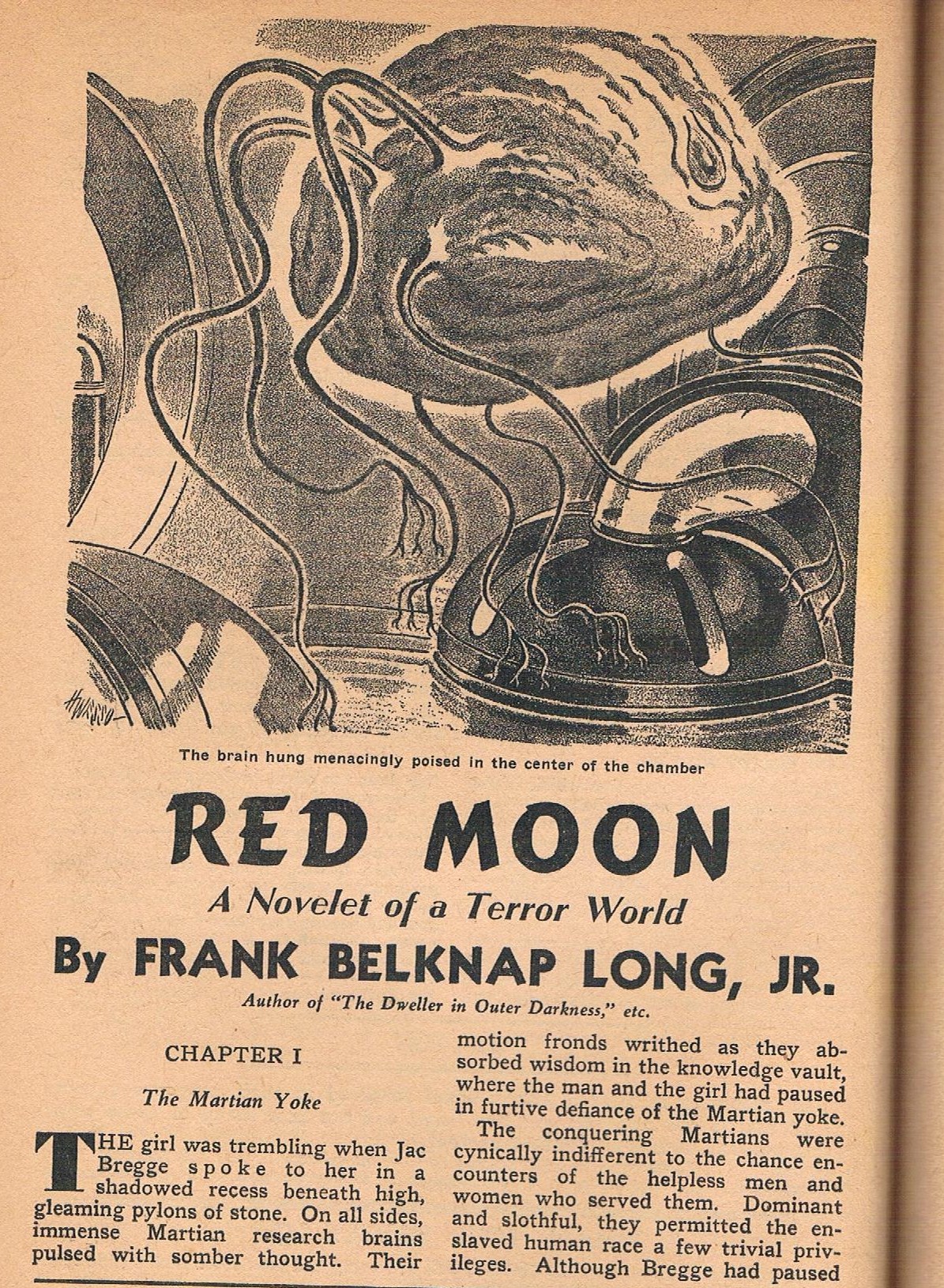
They do definitely lurk. Every now and then I make a heartwarming discovery. Yesterday evening, for instance, as I browsed among my issues of Thrilling Wonder Stories, I came across a tale I can't remember having read or seen before. It's Red Moon, by Frank Belknap Long Jr, in the June 1940 issue. The tale is quite short (about ten pulp-magazine pages), but generous. It provides the reader with domination of Earth and many other worlds by impressively fearsome Martian brains, plus a refuge for free Earthmen on the Uranian satellite Titania (the "Red Moon" of the title), plus a space-faring creature which attacks ships in the void! Classic stuff, and written with vigor and - in some spots - with considerable literary skill.
...Audacity ebbed and flowed, ebbed and flowed in him as his agitated gaze swept the sleeping brain. He was resolute one instant, appalled and shaken the next.
No one before him had ever conceived the crime Jac intended committing. He was about to murder a Martian. Murder - that strange, sinister word from the remote past of the human race. Bregge knew that even if he escaped, the detector brains would pursue him across the Solar System.
Detector brains punished human lapses and criminal infractions of the Martian law. He had picked the word Murder, in the knowledge vaults, had heard it lisped in an audio-trone. In the dim past of his race, men had murdered men. But no man had ever -
His hand tightened suddenly on the sear-blade. The Martian was stirring sluggishly on the slab. The one lidless eye was growing larger, its pear-shaped circumference quivering, widening. Suddenly it blazed with a furious awareness in the half-light.
It's the kind of story which focuses upon one isolated human drama against a vast background. The details of that background are somewhat blurred, suggestive. No more can be achieved in such a short space. The shape of the plot is just right to achieve the maximum effect out of a few pages - like a skilled gardener making the best use of a small area. Red Moon contains the murder, the escape, the pursuit, the discovery of a refuge, and during all these sections of the story we are doled out some helpings of context so that the wider background seeps in to our awareness as readers.
What rests in my mind afterwards is the imagery of those monstrous Martian brains. They make Wells' Martians seem almost cuddly.
2017 March 11th:
CLARKE CLINGS
Arthur C Clarke's Transit of Earth was published in Playboy magazine, January 1971. This was shortly before the Mariner 9 probe reached Mars, in November of that same year. Clarke therefore was writing between the flyby missions (Mariners 4, 6 and 7) and the first orbital mission - in other words, at a time when our views of Mars had touched rock bottom as far as hope for life was concerned. The flybys appeared to show that Mars was geologically dead, like the Moon, whereas Mariner 9 was to reveal a geologically varied world, with a lingering potential for life.
It's intriguing to note how Clarke, realist though he is, feels the pull of wishful thinking. He wants to squeeze the last drop of hope out of the apparently lifeless view of Mars.
...That strange group of rocks - the Elephant, the Capitol, the Bishop - still holds its secrets, and teases me with the memory of our first big disappointment. We could have sworn that they were sedimentary; how eagerly we rushed out to look for fossils! Even now, we don't know what formed that outcropping...
That passage is all the more poignant because in real life the recent rovers have found sedimentary rocks on Mars. Clarke's tale, published in 1971, is set in 1984; we are now far further in the future from that fictional happening, than it was from the tale's publication. Mars, though a harsh world, continues to "improve" from the nadir of our late-sixties view. But it hasn't improved as far as to match what happens in the story...
...Brennan was on duty, and woke me up soon after midnight. I was annoyed - it was ahead of time - and then he told me he'd seen a light moving around the base of the Capitol.
We watched for at least an hour, until it was my turn to take over. But we saw nothing; whatever that light was, it never reappeared.
Now Brennan was as level-headed and unimaginative as they come; if he said he saw a light, then he saw one. Maybe it was some kind of electric discharge, or the reflection of Phobos on a piece of sand-polished rock...
Since I've been alone, I've often awakened in the night and looked out toward the rocks. In the feeble illumination of Phobos and Deimos, they remind me of the skyline of a darkened city...
These are the words of a man near death, haunted by loneliness and the natural awe of being on another world. A scientific mind playing with emotions which are consciously known to be misleading. But later, in the last page of the story, the protagonist, and (I suspect) Clarke himself, is saying what he thinks is or might well be true:
...there is life of some kind, down there in the badlands of Chaos II, which we never had time to explore.
Those moving patches on the orbital photographs. The evidence that whole areas of Mars have been swept clear of craters, by forces other than erosion. The long-chain, optically active carbon molecules picked up by the atmospheric samplers.
And, of course, the mystery of Viking 6. Even now, no one has been able to make any sense of those last instrument readings, before something large and heavy crushed the probe in the still, cold depths of the Martian night...
And, don't talk to me about primitive life forms in a place like this! Anything that's survived here will be so sophisticated that we may look as clumsy as dinosaurs...
Transit of Earth shows the pull of the classic Worn-Out-but-living Mars of the OSS that refuses to expire in Clarke's imagination. It's one of those tales, like Larry Niven's The Coldest Place, which help to delineate a chronological frontier in the history of our little corner of literature. I don't know that Clarke ever wrote about life on Mars again after that. If he did, maybe a reader could put me right on this.
As of now, we don't know whether there is life on Mars, but if there is, it seems likely to be microbial. I doubt if Clarke, were he alive today, would hint about big beasts knocking against our landers. For although OSS literature is still very much alive, and good new works are being produced, it has had to part company from planetological realism - and Clarke would always plump for realism rather than romance, when forced to choose between them; the fascination of Transit of Earth is that it shows him delaying that choice as long as possible.
I said that the realism and the romance had to part company. This is true - with one single exception. A good conspiracy theory can still preserve realism while casting doubt upon the results from our probes. For, after all, we haven't actually yet been to Mars to see for ourselves. And now John Greer has fashioned a plot whereby we are being fooled, and the old version of Mars is not disproved but merely cloaked from the eyes of our instruments.
Come to think of it, even when we do get to Mars, we might still be fooled. Think of Bradbury's Third Expedition in The Martian Chronicles. A physical weak, mentally powerful race might have no other option.
All sorts of ways it could happen... yep, forget what I said earlier about "parting company": the OSS is not only alive and well in its eternal indestructible "dreaming wing"; its "realism wing" is also back in business.
2017 March 10th:
COSMIC DISGUISES AND IDENTITY-SHIFTS
Getting excited by John Greer's remarks in But Is It NOSS? - I want to sort out some ideas and terminology. Being keen on "reality creep" or "reality engineering" as in Robert Gibson's Valeddom and Uranian Gleams, and at the same time enthusiastic about Greer's self-disguising Iruwon/Mars, I want to stress that we have two separate themes here. Or rather, two authors and three themes. Let's list them.
In Valeddom, as I understand it, we have "reality creep" - a blindly malevolent degradation of worlds, a kind of mindless version of the intelligent disguise in Greer's plot, except that it involves a real change rather than a cloaking illusion.
In Uranian Gleams, we have "reality engineering", or its aftermath: a truer-than-now version of Uranus brought into being or "fostered" by the unimaginable powers of the 36th century.
And in Iruwon we have "reality disguise", quite different from both of the above, insofar as the world does not change its nature - merely the perception of that nature. Greer's plot therefore is "hard" science fiction, really - since it gives us good reason to believe that the traditional inhabited Mars is actual hard reality. It's just a technical matter of fooling our instruments. After all, it wasn't that long ago that reputable scientists believed there might be intelligent life on Mars. I seem to remember that Shklovsky, who co-authored Intelligent Life in the Universe with Carl Sagan, at one time believed that Phobos might be an artificial satellite put up into orbit by the Martians.
So there are the three labels I'm offering. And the concepts to which they refer are, in turn, quite distinct from the options we get from S M Stirling and Michael J Martinez. And they in turn are different from one another...
Stirling's is an "alternative reality" OSS - there's no suggestion in Stirling that there is any scheme of things other than the one in his book. No chance of a cross-over, no way of straddling two cosmoses. You read his books and enter his version of reality and accept it as the reality until you put the book down.
And that, in turn, is different from the "parallel realities" in Martinez' Daedalus series, where you do have cross-overs.
What an abundance - reality-creep, reality-engineering, reality-disguise, alternative reality and parallel reality. 5 cans of literary soup with different yummy ingredients.
Does anyone wish to amend, refine or augment this list of terms?
2017 March 9th:
ARE DEFINITIONS USELESS ANYWAY?
Having recently expended some thought on trying to set down criteria for an ideal OSS series, I now pause to think about how useful definitions are.
I think of the recent (2006) hoo-ha when Pluto was "demoted" from "planet" to "dwarf planet".
Pluto is just the same now as it was before 2006. It was re-defined not for what it was but for what other bodies were discovered to be.
Fair enough, in one sense. Similarly, Ceres was defined as a planet when first discovered - in 1801 - and only became an "asteroid" when it became apparent that there were too many other tiny "planets" of that sort, a whole belt of them between Mars and Jupiter. Again, a question of perspective. If Ceres had been the only port of call between Mars and Jupiter it would have been thought of not as an "asteroid" but as a planet - albeit the smallest one.
But the real problem is more than one of perspective.
"Planet" is a category which we invented in the first place. It really makes no sense to ask, "what is a planet?" A planet is whatever we decide is a planet! Nature does not furnish her products with titles or name-tags.
This drives me towards thinking that the definition of a planet is cultural. Being thought of, traditionally, as a planet, makes Pluto a planet, no matter what the IAU may say.
Similarly, when stellar proper motions eventually cause stars to cross their IAU-agreed constellation boundaries a few centuries hence, I vote we continue to call the stars by their traditional designations, even if Alpha Whatever has crossed over into the zone of Alpha Somethingelse.
Now, about the OSS. The definition of the genre must include some emotional as well as logical boundaries. This, I think, is why I hesitate to include the Daedalus series in the main sub-genre. But it's a qualitative judgement, not a logical one, that makes me stipulate that the laws of nature ought to be more or less the same as the ones we know for the story to count as OSS. (Explicitly, that is. Of course OSS stories contravene nature in all sorts of ways, but not according to the story itself. That is what makes Daedalus different - the story actually is about a dimension with different laws.)
The cultural drag-anchor that makes me still call Pluto a planet, makes me ascribe this rule about the laws of nature to OSS tales.
To re-iterate: I am not saying OSS science must be possible. Of course much of it definitely is not. Conversely, I am not saying the Daedalus science is impossible. In fact I think it quite possible. It's not a question of whether it's possible, but of whether it's sufficiently traditional for genre continuity.
I suggest we view the Daedalus series as part of a new subgenre budding off from the OSS. We need a new name for it. Like the astronomers of the nineteenth century had to invent the term "asteroid"...
2017 March 8th:
COLOURISING
You know how sometimes an old black-and-white film is "colourised" so that it can be reissued with the extra "realism" of the added colours?
I doubt there's much point in doing it with classic films. Who'd want to watch a "colourised" version of High Noon or The Maltese Falcon? The black-and-white is part of the atmosphere.
However, I begin to wonder if some almost-good OSS tales could be... not "colourised" but somehow deepened.
Take a novel which has some good things going for it, but which is disappointing in many respects. Could it not be re-done in the spirit of the author yet with added closeness to what it ought to have been?
How, you may ask, can one judge what "ought to have been"?
Well, how can one dare to do anything, for that matter? We just need an arrogant author who thinks he knows best and happens to be a genius too. Some film remakes are good, after all.
One candidate for this treatment I think is Doc Smith's Spacehounds of IPC. It's not so good that tinkering with it would be lèse-majesté, yet it's good enough to make the effort tempting.
Er - I've just thought of a problem.
The genius author isn't going to bother with "remakes" - he's going to be producing original works of his own. He'll leave the "colourising" to second-raters.
Clunking Callisto! This scuppers the whole idea.
Ah, but wait. The genius may want a rest every now and then, and just have a bit of light fun. It just might be possible, then, that some day someone may toss off an enhanced, melliflously stylistic, de-lectured Spacehounds of IPC...
2017 March 7th:
A TUG-OF-WAR BETWEEN INCOMPATIBLE VIRTUES
The following remarks apply to all adventure stories, not just those set in the Old Solar System, but perhaps they are especially apt for OSS scenes.
A series of adventure tales has to be set in a sufficiently basic environment to include peril and uncertainty and mystery. That means there's a "pull" towards primitiveness.
At the same time, to make the story's settings interesting, there's an opposite pull - towards developed and sophisticated societies.
The bridge between these two opposites is the need for mystery. In order for there to be mystery, there has to be something advanced enough to create the mystery.
How, then, can a society be advanced enough to create mystery while being primitive enough to allow adventure?
That's the tightrope which authors must walk. In practice the problem is solved by secretive advancement.
The Llari in Brackett's Enchantress of Venus, or the Shandakorians in her fine old Mars tale about that city, have advanced and sophisticated powers, but keep them to themselves. It's up to an outsider to venture into their zone and penetrate the mystery.
I can also consider Barsoom in this context. I feel that there is perhaps an illusion to which readers are prone when reading the Barsoom stories. The outgoing mentality of the people of that version of Mars is so impressive, their zest for life so great, their whole civilization so colourful, that one is perhaps misled into thinking it is stronger than it really is. Perhaps the Barsoomians are merely hanging on by the skin of their teeth in a largely adverse environment. In which case, they're not so much a successful global society as a patchwork of local mysteries, albeit with more mutual contact than the cities of Brackett's Mars or the states of Burroughs' Amtor. Barsoom, therefore, can also be made to fit the "local secretiveness" pattern. This is most obvious in the case of the kaldanes, and the people of Horz, and other isolationists of that sort.
A different solution is achieved by Robert Gibson in Uranian Gleams. Gibson is free to use sheer distance as an isolating factor, for Ooranye's diameter is over three times that of Earth - and about six times that of Mars. Its surface area is therefore about ten times that of Earth and almost forty times that of Mars... so even though the Uranians are very advanced, they have plenty of scope for adventurous inter-city voyaging...
Which just goes to show how important it is, that writers should take to exploiting the under-used possibilities of the giant worlds in our System.
2017 March 6th:
PARAMETERS OF AN IDEAL
I wonder if one might compose a list of ideal characteristics of an OSS series. Here are some thoughts:
(1) It should be roomy and ramshackle, rather like a Solar System equivalent of James Schmitz' superb "Hub" milieu. (No rigid political unities, no totalitarian System-wide tyrannies to cramp adventurers' styles.)
(2) It should not depend upon the suppression of Earth - e.g. if Mars and Venus are colonized, it should not be because Earth has been made uninhabitable. That unfortunately precludes the masterpieces of the Kuttner-Moore Venus.) Earth, in other words, must be allowed its place among the planets.
(3) No spoil-sport science. The various worlds should be inhabited by natives as well as by Earth colonists or adventurers. (The Earthlings may or may not be able to breathe the air but they should be fairly free to move around.) Maybe one might make an exception and allow some uninhabited asteroids. Geophysical generosity should allow Mercury its Twilight Belt, and the giant planets should be accessible - should have solid surfaces. Some of the bigger asteroids must be allowed to have thin atmospheres. Pluto (needless to say) must count as a planet.
(4) No COMOLD.
What do readers think? Any amendments necessary, any other stipulations? Have I got the four main criteria here?
This is just a fun list, of course. One wouldn't want authors to suppress good ideas just because they overstep the boundaries laid down. We don't want to be like the Academy Française or whoever it was who thought up the "unities" of classical drama!
[Note added 7th March: for a response to the above see A Fifth Parameter.]
2017 March 5th:
JUST INSIDE THE BORDERLINE
OSS but only just - squeezing into the category - there is a two-volume tale which has a Mars and Venus that are quite orthodox, but an Earth which exerts power over them in a somewhat anachronistic manner.
...The enemy pressed at them hour after hour, but it was clear to Lord Creg that King Winatgin was not using his forces to the best advantage. Their efforts were clumsy and heavy-handed. They were easily outmaneuvered and towards evening, by leading a cavalry screen to hold up the Martian army, he was able to break contact completely.
That night the Linnan army had a much-needed rest, and Lord Creg's hopes came back. He realized that, if necessary, he could probably re-embark his forces and get off the planet without further losses...
Empire of the Atom and The Wizard of Linn by A E van Vogt are works which I ought to discuss on a dedicated page on this site, when I can get round to it. In the meantime may I simply point out that this is a quite remarkable case of writer's magic. The anachonistic scenarios in which a future Earth ruled by a Caesar-type dynasty send warriors out in spaceships to conquer our neighbouring worlds with "cavalry" ought to be rididulous, but they work. Even the hostile critic Damon Knight had to admit they worked, in the sense that the power-play of the main characters were compelling enough to keep the reader turning the page.
To sum up: I reckon these works are just inside the traditional OSS sub-genre, perhaps to the same sort of degree as the Daedalus series by Martinez is just outside it.
2017 March 4th:
A COLOURFUL FUTURE IS OURS, NO MATTER WHAT
Browsing, Poe-style, in my old volumes of forgotten lore - in this case my old sf magazines - I came across Ben Bova's editorial in the December 1974 Analog.
...There will be no second chance. If we don't reach out to the Solar System now, by the time we have gutten our own world and realize that we must seek resources elsewhere, we'll have neither the resources nor the energy to explore the remainder of the Solar System and utilize the wealth that lies there waiting for us. The next few decades are the crucial decision-making time for the human race...
Well, from that point of view, it looks as though the human race may have muffed it. It's too early to be sure, and we do have chaps like Elon Musk, but I for one am unimpressed by the progress in astronautics during the 4.4 decades since Bova's article.
But the good news is, we're being excitingly science-fictional, whatever we do! Time does not stand still; it bears us towards either a Clarkian or Heinleinian future, or towards a Stapledonian mixed disaster-and-triumph future, or to a colourfully sinister CAS Zothique-style future, or... name what you like, it'll be interesting. Failure is as interesting as success.
After all, look at OSS Mars: crumbling ruins, sinister old civilizations... it looks as though our world of Jasoom may be headed that way. (See my page on Star's Reach.) We'll be able to do more than just read about brooding, decaying worlds - we'll be living on one!
Let me share a secret: I hold very old-fashioned moral views. I love reading about old times - I am currently enjoying Arthur Conan Doyle's Micah Clarke (set in 1685, during Monmouth's Rebellion) - partly because of the historical interest and partly because I love the dignity and decency of old-time characters and their pre-permissive society, so greatly inferior to our society in social conscience, yet so greatly superior in personal dignity.
So how do I endure the constant bombardment of obscenity in our current culture, the daily assault of the mutual disgust and rejection between myself and the milieu in which I am forced to live?
Answer: science-fiction! That's my salvation. That keeps me sane. I know that I am inhabiting a real epic of shuddersome planetary evil that even Lovecraft couldn't have dreamed up. Great stuff - can't wait to see what happens next.
2017 March 3rd:
MORE "TOPOLOGY"
Using the term "topology" in a sense that's analogous to its mathematical meaning, which is to do with geometrical relations not involving quantity, I adapt it to the literature of the OSS, for example with reference to the fact that Pluto in stories doesn't have to be killingly cold so long as it is described as colder than Earth. It's the comparison that counts.
I came across a cute example of this in an old comic. It's the only one I still possess out of my once extensive collection; there's no date on it, but it's "Fantastic Tales" No. 2, and its price was one shilling, so that shows its age (and mine).
One of its stories is "Riddle of the Runaway Earth". An archaeologist finds that one of the statues on Easter Island is hollow. Inside, there's a telepathic recording left by a race of benevolent super-beings from another star, which explains that Earth was once the ninth planet, further from the Sun than Pluto. As a kindly gesture, the beings moved the planet to its present warmer position, third from the sun, in order to benefit the natives - primitive ape-men who weren't getting anywhere because their world was somewhat thermally challenged...
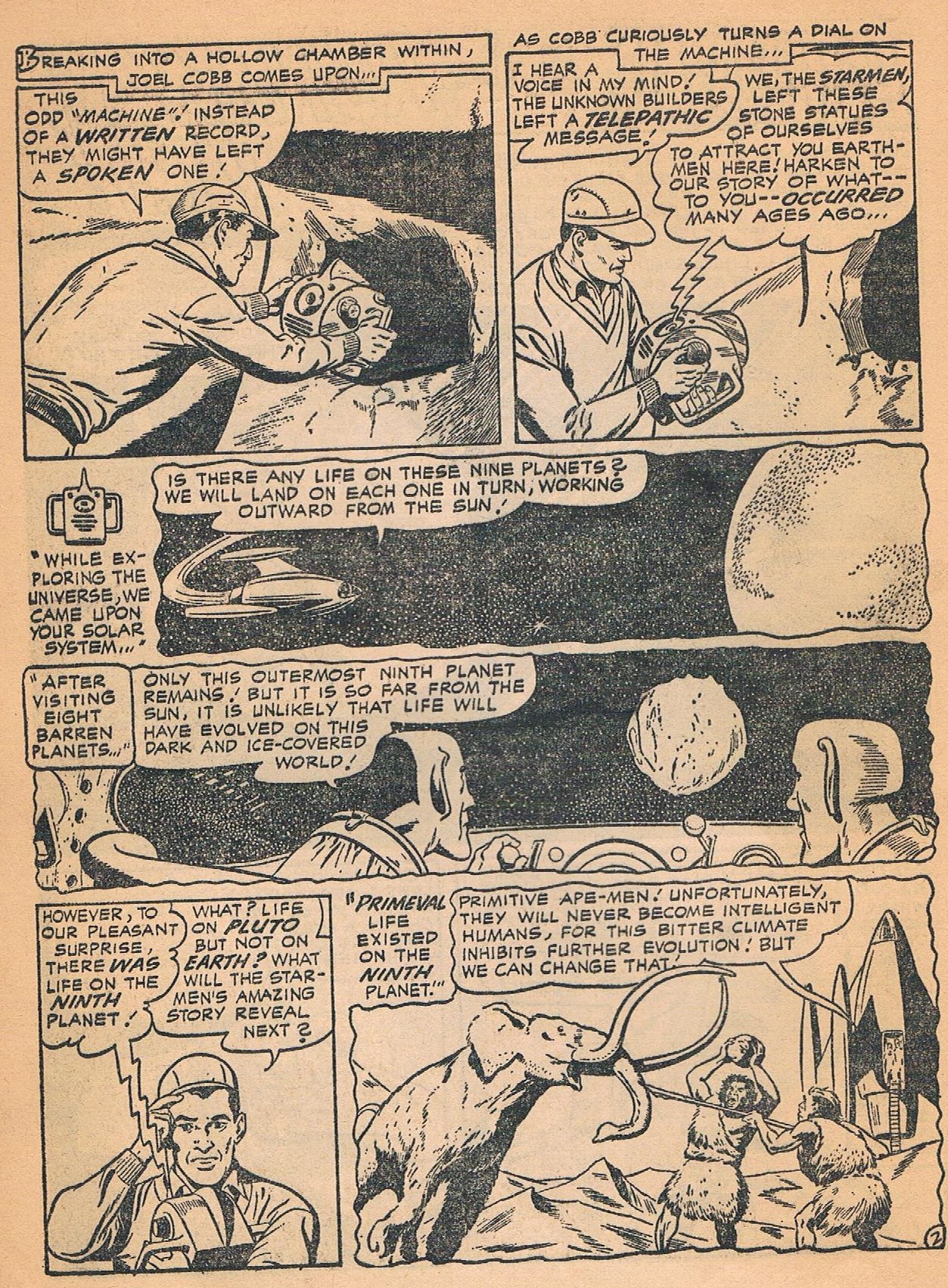
There's the topology of it, you see. Beyond Pluto, it's quite chilly, and you have to go around in warm furs. No talk of frozen-solid atmospheres or liquid helium or anything too extreme like that. It's just rather nippy out there, enough to discourage civilization.
Well - the title of the comic is, after all, Fantastic Stories.
One can argue about how much a reader ought to be prepared to accept, of this sort of thing. My view is that stories which are only topologically accurate without being quantitatively accurate can still be fun. What would definitely not work, in any literary sense whatsoever, is a story which tried to pass off a world on the fringe of the System as warmer than Earth.
Unless, of course, that outrageous fact was the main point of the story... e.g. a world heated by some mysterious internal source. Or existing in an as-yet unsuspected belt of strange heat-giving radiation encircling the Sun at about 40 AU...
Goodness, this suspension-of-disbelief business is complicated...
2017 March 2nd:
CYCLICAL OSS
Today I saw to the Zones Cup, which Mars has won again - to my lack of surprise. The Martians are the site's superpower at the moment, but who knows what turn of Fortune's Wheel lies ahead? And more seriously, what about the possibilities of great fiction, embodying a long-term cycle of the Solar System's history?
It has happened in Earth fiction: the destiny of the far future arching round to resonate with the far past. Two examples come to mind:
In The Book of Ptath by A E van Vogt, set 200 million years in our future, a super-continent called "Gonwonlane" recalls the ancient Gondwanaland; while in Clark Ashton Smith's Zothique cycle, the correspondence is ideological rather than geographical - the far-future return to magic and to antique social structures.
Both ideas make sense. Continental drift will eventually re-create a super-continent. And as for future medievalism - when the planet's resources are depleted, when metal is scarce and industry virtually impossible, the scenario seems eminently reasonable!
But what about the other worlds?
Here I have one suggestion to offer. Bear in mind that for OSS literature the role of scientific truth is to provide props and (as it were) colourful ideological costumery, rather than a rigidly prescriptive logic. It's a sort of topology of the mind. So - how about using the general idea of the future heating of the Sun, to imagine a correspondence between the far past and the far future of the gas giant worlds?
For example one could have a story in which the Jupiter of the distant past, still hot, warms its satellites and allows life there. Then the planet cools and they freeze and the life goes into abeyance - a hibernation of some sort, perhaps in some dimensional refuge, lasting gigayears.
Then the expanding red-giant Sun warms the outer Solar System and the worlds stir with re-awakened life...
2017 March 1st:
SITE SURGE
I may not have time for a normal diary entry because the end-of-month stats will keep me busy. But - I shall at least announce the good news, that after two mediocre months the usage of the site surged in February. It was a record month for users (1,090), visits (3,774) and page views (9,919).
The top ten most popular pages in February, with their number of views, were:
1. Home page 1,490
2. OSS Diary 520
3. Clark Ashton Smith 309 (this is an amazing surge over last month's total of 91,
and is especially gratifying for a CAS fan like me)
4. Man of the World 296 (well done Robert Gibson)
5. Archives of the Moon 204 (ditto)
6. What's New? 148
7. Mars 119 (almost double last month's 61 - what's got into the Martians? Have they
discovered how to hypnotize the users? If so I wish they'd teach me)
8. Mercury 114
9. Wanderers of Mars 105 (well done Dylan)
10. The Asteroids 91 (again hurrah - I'm an Asteroid fan)
On the page view winners page I have summed the figures for January and February to display the aggregate viewing figures for all the "super-pages" so far this year. ("Super-pages" are those with on average one or more views per day.)
Geographical spread of visits:
US 68% China 8% Ukraine 6% Germany and UK 4% France 3%
Canada and the Netherlands 2% Spain and Japan 1% Others 5% (the site was viewed from 72 countries altogether).
